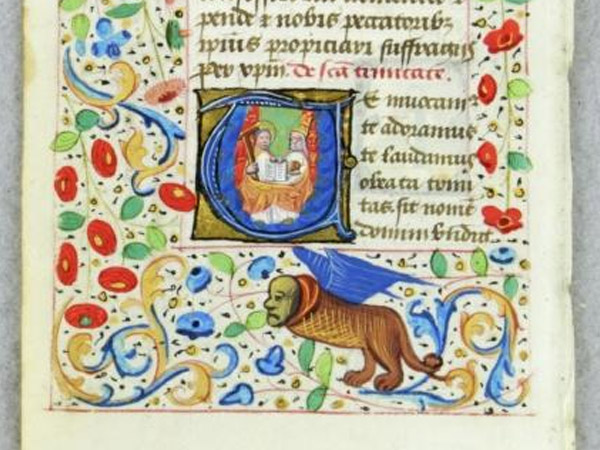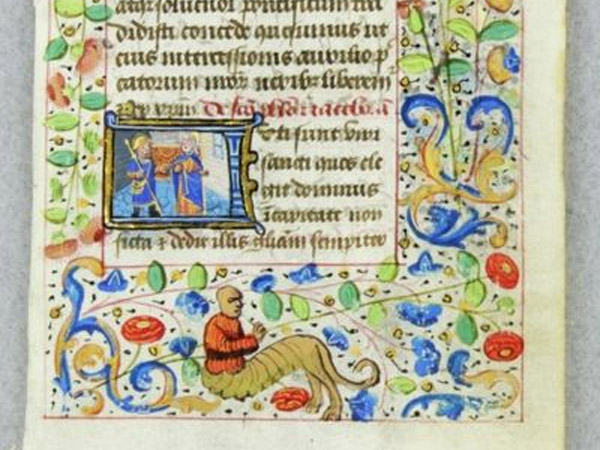At an expedition to The Cloisters, I found a couple neat leonine creatures that piqued my curiosity about lion hybrids in medieval art -- see this blog post. I wrote to the Cloisters archives and asked for some help. The Cloisters librarian, named Michael Carter, kindly offered some more information.
This fresco included a detail with two odd winged bipedal creatures with the hindquarters of lions.

Here's the background info from Carter on the above art:
Dragon: 31.38.2a, b
Department: The Cloisters
Object Name: Fresco
Current Title: Dragon
Classification: Paintings-Fresco
Label Text: This wall painting and its companion, which depicts a lion, are closely related to a cycle of frescoes at Sigena (Huesca), thought to be by an English painter from Winchester. Notwithstanding attempts to find symbolic significance in these beasts, contemporaneous texts state the "images of animals, birds, and serpents and other things are for adornment and beauty only."
Date Label: after 1200
Culture: Spanish
Found: Burgos, Castile-León, Spain
Medium: Fresco, mounted on canvas
Description: PANEL: wyvern; background dark gray, frame of tan, decoration outlined in black; wyvern mottled buff shaded with tan and dark red; above, border of geometric figures and indistinguishable motives in gray, red and tan; at left, border of leaf-like shapes in buff with dark red shading and gray veins; at right two conventionalized trees in rose, red and tan, one with oval white fruit.
Attributes: MED: Wyvern / Mythical Beasts / Animals / Flora and Fauna / [Subject heading]
Dimensions: Overall: 131 x 132 in. (332.7 x 335.3 cm)
(top panel): 83 x 132 in. (210.8 x 335.3 cm)
(bottom panel): 48 x 132 in. (121.9 x 335.3 cm)
Provenance: From a room above the chapter house of the Monastery of San Pedro de Arlanza, near Hortigüela, Burgos, Spain (sold by the government in the nineteenth century)
Also at the Cloisters, I saw this beauty, in an illuminated manuscript, very reminiscent of the fresco detail, that is, human from the waist up, with the hindquarters of a lion, and with wings on its hips.

Regarding this, Carter had less to say: "I’m afraid that nice book of hours that you also noticed is actually a loan item, so it’s not included in our database. I see that it is a promised gift, however, so perhaps one day we will have it in our system."
Over the month since hearing from Michael Carter, however, I've found that the term "book of hours" offers a rich trove of references, once one knows to google it. Starting with the Wikipedia entry on "Book of Hours" I found this illustration:

This is a calendar page from a book of hours. No wings on this lion-human hybrid, an enthusiastic reader!
Here's another winged lion-human hybrid from an illuminated manuscript, this time a musician:

This lion-human jester, with no wings, is described as a "drollery, or grotesque, from the margin of folio 33b: a centaur dressed as a jester":

This one, from ViaLibra, evidently an online antique book marketplace, is described as "a human-headed grotesque" with flapping wings:

This last one to my eye looks the most like a liontaur or wemic, or at least one that has had its forelegs amputated! From the same website, maybe from the same folio (France, 1470), this one is described in the catalog as "a prominent hybrid beast featuring the torso of a man and the hindquarters of a lion":

Well, I have to admit, these are none of them really wemics at all. But they are cute, are they not, these drolleries and grotesques? I hope that the cloistered monks who doodled them into their prayer books would be glad to know that they are as delightful today as they were so many hundreds of years ago.